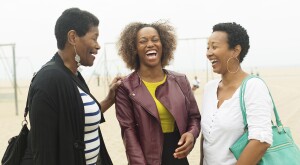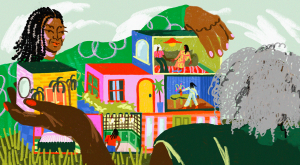On 9/11, after the twin towers fell, my sister asked me to be on the lookout for my nephew, who was walking home to Brooklyn from his school in Manhattan. I remember my stomach filling with acid as I waited, unsure of what was going on or if more terrorist attacks would happen. When Kenji finally arrived home, I exhaled, and then I asked, “Can I get a hug?” I’m not much of a hugger, but I sure needed one that day.
A few years later, the day after I had to put my beloved cat Shakespeare to sleep, Angel, my nephew’s cat, perched herself on the newel post on the staircase outside my apartment. She rose up on her hind legs, placed her furry paws around my neck and rubbed her face upon my cheek. I kid you not. It happened. I almost cried. It felt so good. It seemed like she instinctively knew I needed a hug. My feelings of sorrow and guilt began to ease.
And now, during the COVID-19 pandemic, when social distancing itself is an act of love, virtual hugs have become the norm.
“It’s really strange. I so miss the touch,” says massage therapist Connie Wingo. “It feels like a psychic amputation.” She not only misses providing healing touch, but also being the recipient. “I am a big hugger and believe I miss not hugging the most,” she continues. “I really feel a void and incomplete connection when I can’t hug my friends or good neighbors, who I’ve always hugged hello and goodbye.”
There is a biological reason why we crave hugs. “As human beings we are social creatures, and physical touch is such an important part of the human experience, from the time we are nestled in our mother's womb and throughout the rest of our lives,” explains psychiatrist Angela Coombs, of the Columbia University Irving Medical Center. “Hugging and other forms of physical touch are a part of that.”
It turns out hugs, apparently even furry-pawed hugs, are good for us. “We know that hugging can have an effect on us emotionally and physiologically,” Coombs continues. “Consensual hugging, like other forms of desired touch can lead to the release of the hormone oxytocin, which has been shown to activate an anti-stress response. This includes physiologic changes such as lowering blood pressure or heart rate. We also know that physical contact plays an important role in early attachment or in our bonding process in particular relationships.”
While we long for the days when we can experience real physical hugs, right now hugs with those outside our own households can be unsafe and will continue to be so until there is a vaccine. As with handshakes, it’s best to avoid hugging as a casual greeting and to limit hugs to family and close friends.
“As a rule, it is important to [get] consent prior to hugging because, even before COVID-19-related concerns were an issue, this kind of touch is intimate and you want to be sure whoever you are hugging is comfortable with being touched in that way,” says Coombs. “As for how we should approach this, knowing that we are people that need to feel connected, it is important that we continue to follow the guidelines of trusted sources such as the CDC [Centers for Disease Control and Prevention] when it comes to how we physically distance and engage with others and creatively find ways to remain connected emotionally.”
If individuals, regardless of recommendations, still make the choice to hug, Coombs suggests doing it in a way that might minimize risk, such as hugging while both parties are wearing masks and avoiding face-to-face contact, such as in a side hug. Other suggestions from health professionals include not talking (and, of course, don’t cough or sneeze) while hugging. Make the hug brief, then back away to the safe 6-foot distance before having a conversation.
It is safer to have small children hug you around the knees and avoid stooping down close to their faces. Hug outdoors and, if you can, avoid contacting the recipient or their clothes with your face or mask. Finally, while this might be challenging, when greeting someone you’ve been away from for a long period of time, try not to cry. Fluids from tears and runny noses can contain and transmit the coronavirus.
“It’s important for people to know that hugging in this way is not without risk,” Coombs warns. “It is important for people to look for alternative ways to show and demonstrate affection or experience closeness.”

Loris Lora










